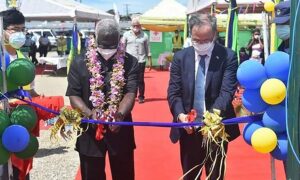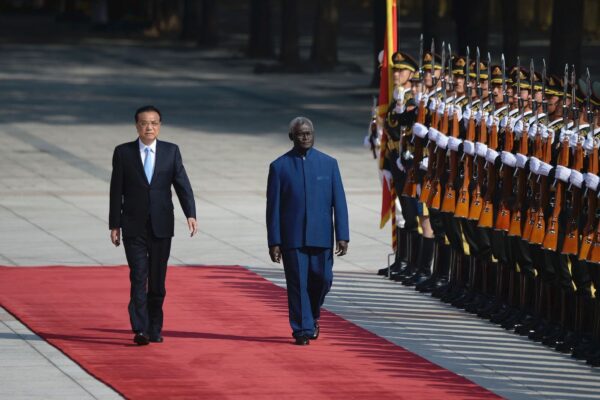Despite Slowing Economy, Beijing Continues Pumping Aid Into the Solomons, Kiribati
Beijing is pumping more money into new developments in the Solomon Islands and Kiribati as “COVID-Zero” policies pummel the Chinese economy.While Chinese aid flows to the overall Pacific region declined from 2016 to 2021, the Chinese Communist Party (CCP) has upped its investment in the Solomon Islands and Kiribati, which switched allegiances from Taiwan to Beijing in 2019, according to Lowy Institute’s latest Pacific Aid Map. “In both countries, sizeable new financing from China has displaced existing support from Taiwan,” according to the Sydney-based Lowy Institute. “China has not given up on using development assistance to cement key relationships.” In April, the Solomon Islands signed a security agreement with Beijing, which raised concerns in the United States, Australia, and other Western countries. Under the agreement, Chinese police security personnel have begun training Solomon Islands police. Kiribati’s rule of law is also facing questions as the government suspends its judiciary. In response, Simon Birmingham, Australia’s opposition foreign affairs spokesman, said the region was an area of concern. “It’s important to make sure we work as closely as we can to ensure Pacific nations who are wanting to advance their democracies, along with economic development, are empowered to do so,” he told AAP. “Where undue restrictions are placed on the media, or where a diminution of electoral processes and democratic processes are occurring, of course, Australia should raise those concerns.” Solomon Islands Prime Minister Manasseh Sogavare and Chinese Premier Li Keqiang inspect honour guards at the Great Hall of the People in Beijing on Oct. 9, 2019. (Wang Zhao/AFP via Getty Images) Australia remains by far the largest source of aid to Pacific countries, the Pacific Aid Map shows. In 2020, Australia provided $1.23 billion (US$780 million) in aid to the Pacific region, far exceeding the $375 million from the United States and $245 million from China. In 2021, Beijing spent $145 million in the Pacific, compared with Australia’s $1.7 billion. Alexandre Dayant, director of the Pacific Aid Program, said there was a “supply and demand problem” with CCP aid money. “On the supply side, China’s economy is slowing down, so it appears there is less appetite for spending money abroad,” he told The Sydney Morning Herald. “We see the slowing down of the Belt and Road infrastructure initiative, with fewer projects committed around the world.” On the demand side, he noted that leaders of Pacific island countries were “waking up” to the fact that the Chinese aid projects had quality issues and were backed by loans with difficult payment conditions. Dayant noted, however, that Pacific leaders were getting better at playing the “China card” to try to extract more aid money from developed countries. In last week’s budget, the Australian government announced an extra $900 million in development aid for the Pacific region over the next four years. Follow

Beijing is pumping more money into new developments in the Solomon Islands and Kiribati as “COVID-Zero” policies pummel the Chinese economy.
While Chinese aid flows to the overall Pacific region declined from 2016 to 2021, the Chinese Communist Party (CCP) has upped its investment in the Solomon Islands and Kiribati, which switched allegiances from Taiwan to Beijing in 2019, according to Lowy Institute’s latest Pacific Aid Map.
“In both countries, sizeable new financing from China has displaced existing support from Taiwan,” according to the Sydney-based Lowy Institute. “China has not given up on using development assistance to cement key relationships.”
In April, the Solomon Islands signed a security agreement with Beijing, which raised concerns in the United States, Australia, and other Western countries. Under the agreement, Chinese police security personnel have begun training Solomon Islands police.
Kiribati’s rule of law is also facing questions as the government suspends its judiciary.
In response, Simon Birmingham, Australia’s opposition foreign affairs spokesman, said the region was an area of concern.
“It’s important to make sure we work as closely as we can to ensure Pacific nations who are wanting to advance their democracies, along with economic development, are empowered to do so,” he told AAP.
“Where undue restrictions are placed on the media, or where a diminution of electoral processes and democratic processes are occurring, of course, Australia should raise those concerns.”

Australia remains by far the largest source of aid to Pacific countries, the Pacific Aid Map shows.
In 2020, Australia provided $1.23 billion (US$780 million) in aid to the Pacific region, far exceeding the $375 million from the United States and $245 million from China.
In 2021, Beijing spent $145 million in the Pacific, compared with Australia’s $1.7 billion.
Alexandre Dayant, director of the Pacific Aid Program, said there was a “supply and demand problem” with CCP aid money.
“On the supply side, China’s economy is slowing down, so it appears there is less appetite for spending money abroad,” he told The Sydney Morning Herald. “We see the slowing down of the Belt and Road infrastructure initiative, with fewer projects committed around the world.”
On the demand side, he noted that leaders of Pacific island countries were “waking up” to the fact that the Chinese aid projects had quality issues and were backed by loans with difficult payment conditions.
Dayant noted, however, that Pacific leaders were getting better at playing the “China card” to try to extract more aid money from developed countries.
In last week’s budget, the Australian government announced an extra $900 million in development aid for the Pacific region over the next four years.












